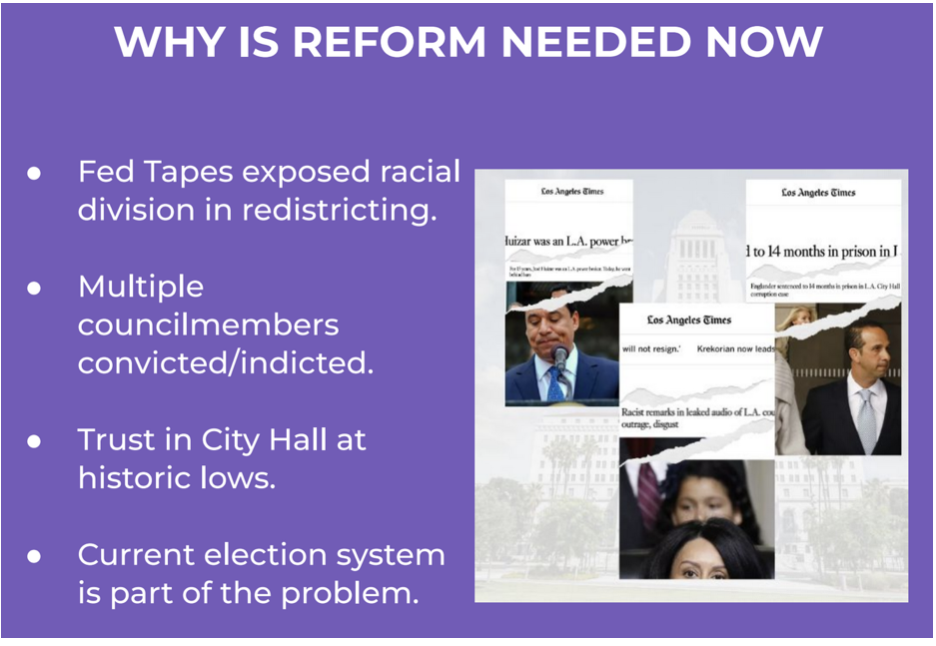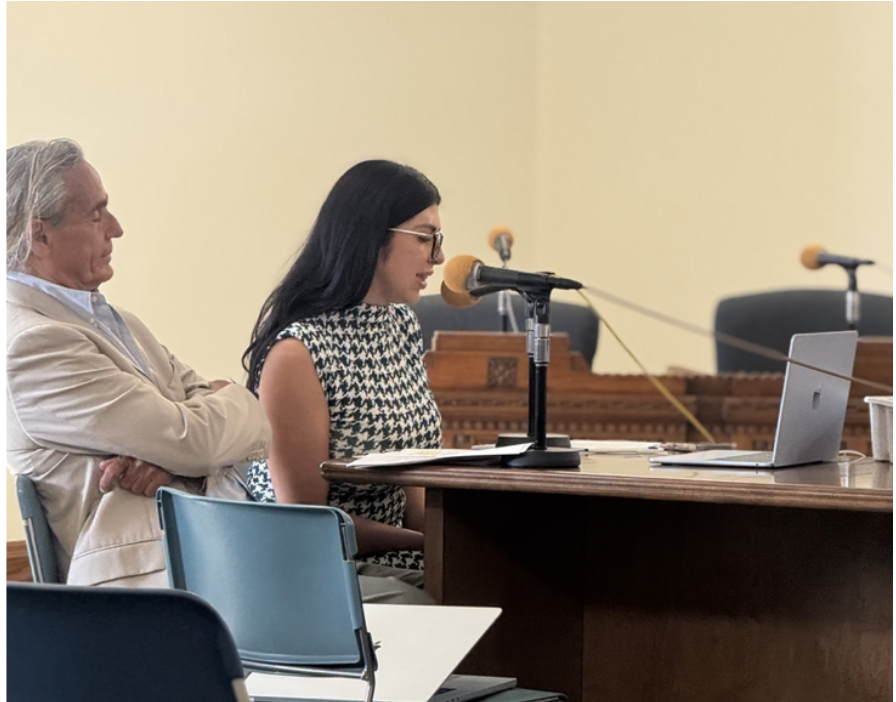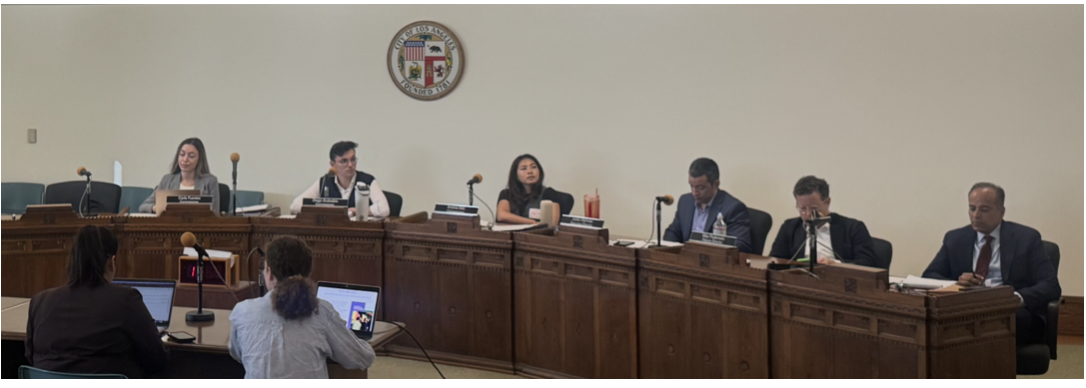Comments
PROP 50 - It seems that everyone is talking about redistricting these days, after Texas redistricted its Congressional maps to gain partisan advantage for Republicans heading into the 2026 mid-terms, with control of the U.S. House of Representatives on the line.
Here in California on November 4 we’ll be voting on Proposition 50, a ballot measure to counter Texas, called the ‘Elections Rigging Response Act.’
Prop 50 would eliminate California’s current Congressional district maps, drawn by the state’s independent California Citizens Redistricting Commission after the 2020 U.S. Census. New maps drawn by the state legislature would take their place, designed to gain partisan advantage for Democrats. After the 2030 Census, the Commission would begin drawing maps for the state again.
The most obvious conclusion to draw from this cut-throat struggle, is that how district lines are drawn greatly affects who gets power. The same is true on the municipal level.
LA Charter Reform - a response to the Federation Tapes scandal

In Los Angeles, the racist, hateful comments by three sitting City Council members — secretly recorded and leaked to the public in Federation Tapes scandal in October 2022 — were made in the context of ‘how to manipulate the LA’s 2022-2032 redistricting process.’
That’s why LA’s current Charter Reform Commission (CRC) process — which began earlier this year — is critical. In November 2024 LA voters approved an Independent Redistricting Commission (IRC) for LA elections, co-authored by Council member Nithya Raman, as an initial response to the Fed Tapes scandal - an important first step.
Now is the time for heavy lifting — City Council reform via City Council enlargement — which the Council itself made an explicit part of the CRC’s mandate.
Discussion of City Council enlargement should include both ‘how many more’ members on the City Council, and ‘how’ they are elected - from using single-seat winner-take-all districts like today, to proportional representation multi-seat districts, using proportional ranked choice voting (PRCV).

On September 25, Marcela Miranda-Caballero, Executive Director of CalRCV and I made a presentation to the CRC Government Structure Committee, in favor of three-seat PRCV districts to elect the City Council.
Here you can see the CalRCV slide show, background reference document and video of the presentation (from 48:01 to 1:17:16).
Preceding our presentation was invited speaker Lee Drutman, a Senior Fellow at the New America Foundation and has written extensively about electoral reform. He argued that single-winner districts were the main problem for LA. He stressed the need for proportional representation, and advocated three- or five-seat PRCV districts to get it.
Independent redistricting - necessary but insufficient
An illuminating way to see why PRCV is needed, is to understand why LA’s IRC process is necessary but insufficient. Necessary, because politicians shouldn’t be drawing district lines, given the obvious conflict of interest. But insufficient, because an IRC doesn’t address the root conflict behind the Fed scandal — the zero-sum representation nature of single-seat districts.
Even with an IRC and a larger city council (with more seats and smaller districts to draw lines for) — redistricting for single-seat districts in LA would still be a discretionary choice, about which voters get grouped together to elect a single winner — and win power.
Because LA’s system is winner-take-all, it inherently and inevitably pits various racial/ethnic communities’ representation against each other — some protected classes under the California Voting Rights Act. Depending upon a district’s demographics, it may be any combination of Black vs. Latino vs. Asia-Pacific Islander (API) vs. White vs. ‘other.’
At the same time, representation suffers because large blocks of voters representing a range of political viewpoints are shut out if they are a political minority in their district — even if they make up a significant portion of the electorate.
Why not adopt a different voting system, where various communities can each win seats within each district, proportional to their numbers? That possibility is before the Charter Reform Commission with multi-seat PRCV.
Proportional ranked choice voting (PRCV) from three-seat City Council districts
In much of LA, the largest demographic by precinct is White or Latino. Under single-seat elections, the largest demographic group usually determines the winner. And the other voters? None of their votes go towards electing anyone.
In recent three-seat PRCV city council elections in Portland, Oregon, 87% of voters had their vote going towards election at least one winner. That’s because the process is fundamentally different with PRCV districts. In a majority White PRCV three-seat district, you might have one White-, one Latino-, one API-community supported winner. Or two Latino- and one Black-community supported winners in another. And so on.
How might this play out in LA? Prospective mapping is being done by academic and non-profit organizations, to envision how larger City Councils elected from single-seat and/or multi-seat districts might compare and contrast in promoting better representation for LA.
The results will be presented at the October 16 meeting of the Government Structure Committee, which ultimately will be making recommendations to the entire CRC. The CRC as a whole will then be making recommendations to the City Council. Then the City Council can decide whether and what to put on the ballot for a public vote, including amending or substituting for the CRC’s recommendations.
The path to the ballot for needed reform is a long one. But for now, the focus is on exploring council enlargement, and manners of electing its members.On October 16th, the Government Structure Committee meeting will take at 4:00pm in City Hall Room 1010, if you can attend in person. Or you can watch the meeting by zoom here. Beforehand you can submit public input by email.
But ironically and lamentably — if not contradictorily for a reform process that is supposed to involve the community deeply — you can’t give public input virtually to the CRC, as a whole or its committees.
On the positive side, the Government Structure Committee is made up of the three youngest members of the CRC — younger minds that may be most open to transformative vision.

They are (left-to-right in the photo above): Carla Fuentes, Social Innovation Manager at the Goldhirsh Foundation, and a board member with the League of Women Voters of Greater Los Angeles and LA Forward; chair Diego Andrades, Assistant Director of the USC Dornsife Center for the Political Future; and Andrea Mac, Programs Coordinator at the Center for Asian Americans United for Self-Empowerment (CAUSE).
Resources:
• LA Charter Reform Commission
• Proportional RCV Information FairVote
• CalRCV - Los Angeles
• FairRepLA on LA Charter Reform
• New Democracy Institute - Los Angeles
• How RCV and PRCV votes are cast (FairVote)
• Graphics on how PRCV votes transfer, (1) City of Portland (OR)
• Graphics on how PRCV votes transfer, (2) City of Portland (OR)
• VIDEO: How Instant Runoff Voting works 2.0: Multiple winners
Minnesota Public Radio, 2:43
• VIDEO: How does Single Transferable Vote Work in Portland, Oregon?
Rose City Reform, 3:11
• VIDEO: How ranked-choice voting works in Portland, Oregon | Elections 2024 | Oregon Public Broadcasting, 5:19
• VIDEO: The Choice Movie - Ranked Choice Voting in Portland, 24:46
———————
(Michael Feinstein is a former Santa Monica Mayor and City Councilmember, a co-founder of the Green Party of California, and a 2018 Green candidate for California Secretary Of State.)






